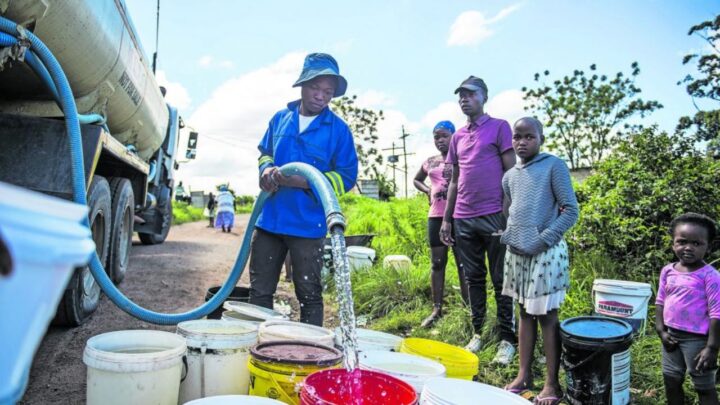South Africans are bracing for yet another utility crisis, as water shedding now threatens to follow the ongoing load shedding. With reservoirs under pressure and infrastructure failures rising, major cities like Johannesburg, Tshwane, and Cape Town could face water supply restrictions. This “double trouble” scenario of electricity and water outages raises serious concerns about daily life, hygiene, and economic activity. Citizens must stay informed about the reasons behind this looming crisis, the affected areas, and how to prepare. Here’s a complete breakdown of the situation and what every South African needs to know now.

Load Shedding and Water Shedding – A Double Utility Crisis in South Africa
South Africa has long struggled with load shedding due to Eskom’s power generation challenges, but now a new crisis is emerging—water shedding. Water supply is being disrupted because pump stations depend on electricity to function. When prolonged power outages occur, water systems can’t maintain pressure, leading to dry taps. Moreover, ageing infrastructure and high demand during hot seasons add to the strain. Municipalities have started implementing water-saving campaigns and scheduling water cuts in certain regions to prevent total depletion. The combination of electricity and water cuts is creating a complex and stressful situation for citizens.
- Load shedding disrupts water pumps, leading to low water pressure or no water.
- High temperatures increase water consumption, putting additional strain on supply.
Affected Provinces and Cities – Where Water Shedding Is Hitting Hardest in South Africa
Water shedding is not uniform across South Africa. Major metros like Johannesburg, Ekurhuleni, and Tshwane have already issued warnings and started implementing restrictions in high-demand zones. Cape Town and Durban are monitoring closely but have not declared formal schedules yet. Rural areas and townships often suffer the most due to weaker infrastructure and less priority in municipal planning. Reports suggest reservoirs are dropping below 30% capacity in some Gauteng regions, triggering emergency plans. If no immediate rainfall or infrastructure improvements occur, more cities could join the water-shedding list within weeks.
- Johannesburg and Tshwane have introduced scheduled water cuts in some suburbs.
- Rural towns face longer interruptions due to lack of backup pumping systems.
Causes Behind Water Shedding – Why South African Infrastructure Is Struggling
There are multiple causes behind the rise in water shedding across South Africa. First, continuous load shedding interrupts electricity supply to water treatment plants and pumping stations. Second, years of underinvestment in maintenance and upgrades have left water systems vulnerable. Third, climate change is contributing to erratic rainfall and drought conditions, worsening the crisis. Lastly, population growth in urban areas is outpacing water infrastructure capacity. Government and municipalities acknowledge the issue but warn that fixing these systemic problems will take time and funding.
- Ageing infrastructure and insufficient maintenance lead to burst pipes and leaks.
- Electricity outages directly impact water distribution systems.

How South Africans Can Prepare for Water Shedding at Home
Preparation is key to dealing with water shedding. Citizens are advised to store emergency water in sealed containers and use water sparingly throughout the day. Investing in water tanks, purifiers, or boreholes (where legal) can offer added resilience. Municipal SMS alerts or apps can notify residents of upcoming disruptions. Communities should also report visible leaks and illegal connections to avoid wastage. Hygiene, especially in schools and healthcare facilities, should be prioritized with regular checks and contingency plans. The key is awareness, conservation, and local preparedness in the face of growing uncertainty.
- Store at least 5–10 litres of drinking water per person per day.
- Limit washing, cleaning, and gardening to essential times only.
| City/Region | Status | Water Level | Water Cut Schedule | Backup Measures |
|---|---|---|---|---|
| Johannesburg | Critical | Below 30% | Zone-based cuts: Morning & Evening | Water tankers deployed |
| Tshwane | Warning Issued | Low | Alternate days in high-use zones | Public alerts via SMS |
| Durban | Monitoring | Moderate | No cuts yet | Reservoir levels being reviewed |
| Cape Town | Stable | Above 60% | Voluntary savings requested | None activated |
| Rural Limpopo | Severe | Under 25% | Unscheduled long-duration cuts | Minimal infrastructure |
Frequently Asked Questions (FAQs)
1. Why is South Africa facing water shedding now?
Power cuts, poor infrastructure, and low rainfall are leading to water shedding.
2. Which areas in South Africa are affected by water shedding?
Johannesburg, Tshwane, and some rural towns are most affected currently.
3. How can citizens prepare for water outages?
Store water in containers, limit usage, and follow municipal alerts for updates.
4. Will this water crisis continue throughout 2025?
Yes, unless infrastructure improves and rainfall levels rise significantly.
How can South Africans prepare for potential water shedding?
By conserving water and planning ahead for disruptions in water supply.





